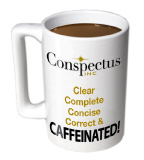I was researching a media-buy for a client, and while perusing a trade magazine's media kit, I came across an impressive statistic: 90% of the people they surveyed read their magazine. Only about 50% of those same folks read the next most popular magazine in that field. Sounded great.
Except that I like context. So I wondered, who exactly were the folks they surveyed?
It turns out it was a survey of their 14,000+ readers. It turns out only 90% of their readers actually read their magazine, and 94% of their readers receive their magazine. This leaves me wondering how they define their readers, since (if you consider their own statistics and use the kind of meatball logic they used) there seem to be some "readers" (6%) who neither read nor receive their magazine.
It did not leave me wondering about the quality of their statistics: I now believe very little of what they say, not without close scrutiny. Clearly, they did not intend me to take away the message that their magazine is so boring that 10% of their own readers don't even read it. Clearly, what they intended was for me not to read the fine print.
Did you really think I wouldn't read the fine print, guys? Did you really think I'd just look at a big number and take out my checkbook?
Personally, I think it would have been wiser to craft a different headline out of their survey data. They could have ignored the percentage of their readers read their magazine (that still twists my brain) and focused on the 50% of them who read only that magazine, out of all the publications in their field. If you're talking to me as a potential advertiser, the idea that the only way to reach those 7000+ people is through your magazine is pretty compelling sales-stuff. Much more compelling than the admission that your "readership" figure is inflated by 10%.
More to the point, their assumption that I wouldn't question their headline, that I wouldn't read the fine print, insults me. It insults my intelligence and my competence at buying media. Insulting your potential customers is hardly ever a good place to start, even if you're a stand-up comedian.
This is a lesson for anyone who designs or approves advertising and sales literature. If you assume the audience is stupid or lazy, you will pay for it. It will reflect badly on you, and invite speculation on what other kinds of deception you practice.
The Moral:
Promote if you can,
Hype if you must,
But trying to hustle me
Busts my trust.
Except that I like context. So I wondered, who exactly were the folks they surveyed?
It turns out it was a survey of their 14,000+ readers. It turns out only 90% of their readers actually read their magazine, and 94% of their readers receive their magazine. This leaves me wondering how they define their readers, since (if you consider their own statistics and use the kind of meatball logic they used) there seem to be some "readers" (6%) who neither read nor receive their magazine.
It did not leave me wondering about the quality of their statistics: I now believe very little of what they say, not without close scrutiny. Clearly, they did not intend me to take away the message that their magazine is so boring that 10% of their own readers don't even read it. Clearly, what they intended was for me not to read the fine print.
Did you really think I wouldn't read the fine print, guys? Did you really think I'd just look at a big number and take out my checkbook?
Personally, I think it would have been wiser to craft a different headline out of their survey data. They could have ignored the percentage of their readers read their magazine (that still twists my brain) and focused on the 50% of them who read only that magazine, out of all the publications in their field. If you're talking to me as a potential advertiser, the idea that the only way to reach those 7000+ people is through your magazine is pretty compelling sales-stuff. Much more compelling than the admission that your "readership" figure is inflated by 10%.
More to the point, their assumption that I wouldn't question their headline, that I wouldn't read the fine print, insults me. It insults my intelligence and my competence at buying media. Insulting your potential customers is hardly ever a good place to start, even if you're a stand-up comedian.
This is a lesson for anyone who designs or approves advertising and sales literature. If you assume the audience is stupid or lazy, you will pay for it. It will reflect badly on you, and invite speculation on what other kinds of deception you practice.
The Moral:
Promote if you can,
Hype if you must,
But trying to hustle me
Busts my trust.













